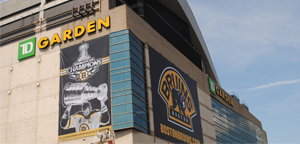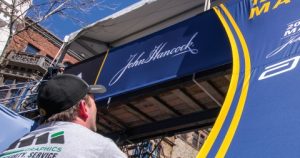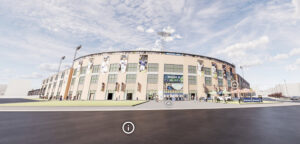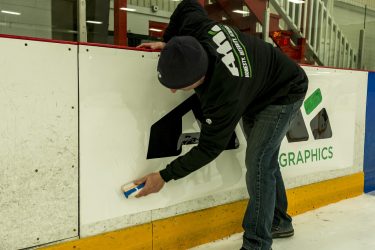[vc_row][vc_column][vc_column_text]With Spring around the corner, it’s time to start thinking about planning for the upcoming baseball and softball seasons. While planning everything from schedules, equipment, promotions, and more may seem daunting, we are here to help make planning your baseball stadium signage a little bit easier with our Baseball Signage Planning Guide as well as the below tips on how to best start your planning.
Our Baseball Signage Planning Guide combines our extensive knowledge of baseball and softball stadium signage into one, easy-to-use PDF download. The Baseball Signage Planning Guide walks you through each area of a stadium while giving ideas for traditional stadium signage solutions as well as ideas on how to add signage to less than conventional areas. Combine this handy guide with our helpful tips below, and you will be ready to put your best foot forward when planning your stadium signage for the 2020 season.
The signage experts at AMI Graphics have over 30 years combined experience working with baseball and softball teams of all levels on their stadium signage. We have compiled some of their top tips to take into consideration when planning the signage, whether branding, sponsor, or operational, for your stadium.
Get Organized
This may sound obvious but will be a major key to your success. Whether it’s creating a master list of signage sizes and locations, or having an outfield map to keep sponsor locations and pad wrap sizes in one spot like the Charleston RiverDogs shown below, having all your ducks in a row will make a huge difference in your stress level and success. We are happy to help with any printed sponsor signage inventory management tools such as dry erase maps and charts that can easily be updated.
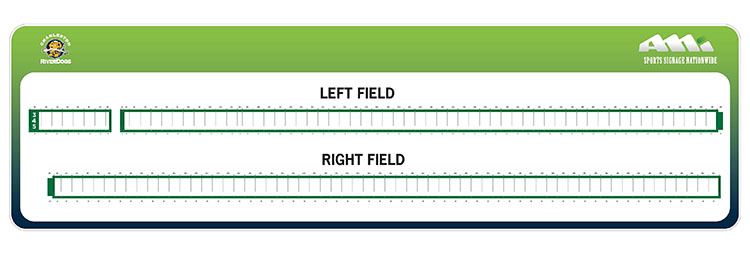
Another helpful resource for planning your stadium signage is our online proofing and production website. This website is a resource that any client can take advantage of in order to upload new files, view and request changes to proofed files, approve files for print, and track signage items once shipped. Additionally, it stores information from season-to-season, including sizes, materials, and quantities, so that you can easily reference what you have ordered in past seasons.
Plan Ahead
This tip is two-fold. General planning for stadium signage requires contacting sponsors early enough for artwork, measuring any new spaces, and seeing what signage inventory might need to be replaced. If you store your signage over the off-season, be sure to take everything out of storage early to avoid any last minute rushes so you don’t suddenly find out two days before the start of your season that you need to replace your outfield banners.
Planning ahead is also essential when pitching new sponsorship locations. Be sure to factor in the needed signage type and installation method to ensure all associated costs are accounted for and that the sponsorship value reflects these costs. If you have any questions throughout this process, please reach out! We are happy to help you determine these factors and provide you with a quote to use in order to properly value your proposed sponsorship.
Know Your Signage Locations
Knowing where you are going to put each piece of signage before you order it will prevent many headaches later. Different areas of a stadium require different material choices. For example, a higher wind area would require a mesh banner that allows air to flow through it as opposed to a solid vinyl banner that would turn into a sail in a high wind area. If you aren’t sure, our signage experts can assist you in determining the proper material for your stadium signage application.
Keep it Simple
With everything that goes into planning for the baseball or softball season, the simpler that you can make things, the better. While each stadium has its own quirks, keeping signage standardized throughout each area of the ballpark will inherently make things easier. If you are looking to have signage throughout your concourse, determining a standard size will help make planning and organizing sponsor signage for each spot much easier so sponsors can be placed anywhere instead of being limited to the one spot that is that particular size.
When selling sponsorships, keep in mind that sponsors sharing the same piece of signage inventory can make future design or sponsor updates more difficult. This is especially true for outfield wall graphics, specifically pad wraps, where sponsors sharing the same placement would require the whole graphic to be replaced to update one part of it.
Don’t Overcrowd Your Stadium with Signage
We suggest balancing your sponsor signage, in any location, with symmetry in its placement. Keeping a symmetric approach in how you place signage gives a better overall appearance to the park without appearing desperate to brand every square inch of open space.
Additionally, if you charge a little bit more for fewer sponsor placements, you create an inherent value in your sponsor inventory while keeping a cleaner look. With fewer sponsor placements available, it can help create a sense of urgency for a potential sponsor to get in on advertising with the team before available sponsor inventory runs out.
While these are some of our top tips, we have many more! Our signage experts are always happy to take on any challenge to determine the proper signage solution for any application. As you are planning for your season, don’t hesitate to reach out at any time, we would love to help. [/vc_column_text][/vc_column][/vc_row]


